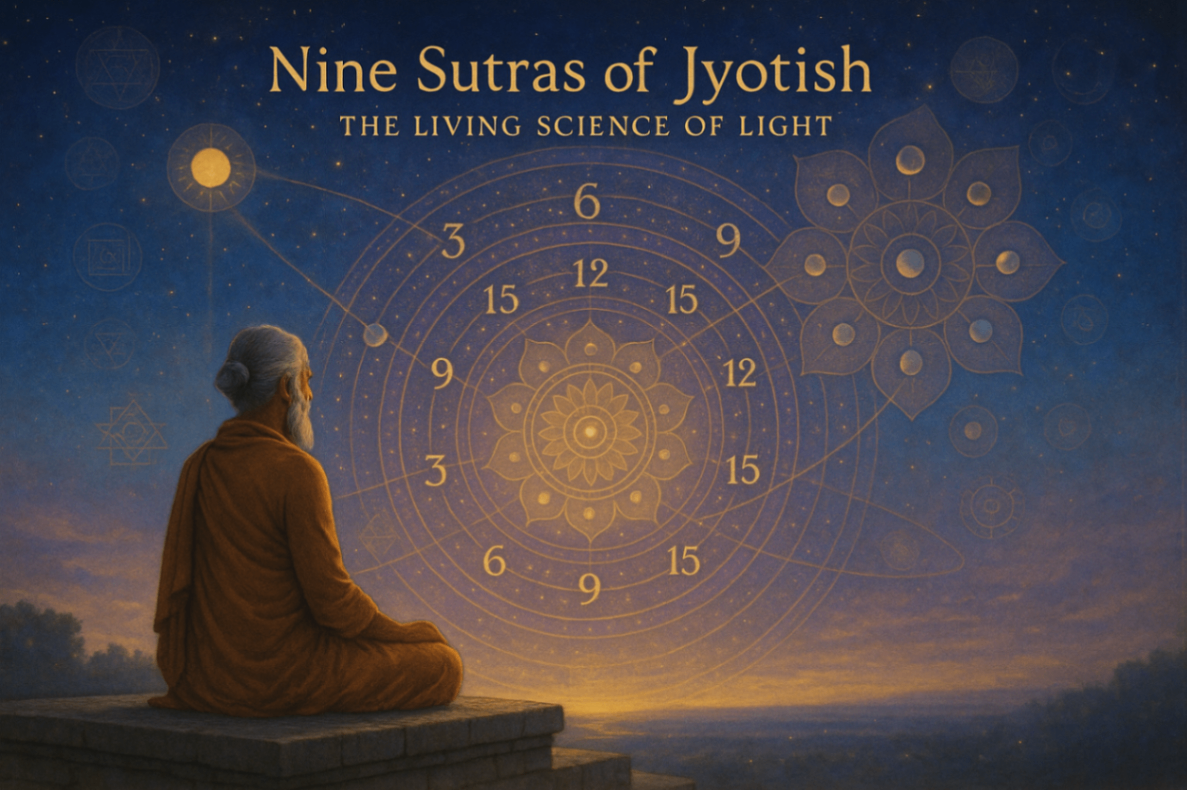Introduction: Jyotish as Cooperation with Time
Jyotish shows patterns in time. It does not remove all hurdles. It teaches you when to act, what to avoid, and how to align your effort with the sky.
This guide offers nine Sutras—simple teachings you can apply right away. The tone is practical, humble, and consistent with traditional logic.
Sutra 1: The 48-Day Mandala—Why Remedies Need a Season
A steady practice needs one full “season” to take root. A classic window is 48 days.
-
A muhurta is 48 minutes. It marks a complete breath of time.
-
The count 9 (planets) + 12 (signs) + 27 (lunar mansions) = 48.
-
Daily effort moves with the Sun’s pace and creates compounding effect.
How to work with it
-
Pick one practice (mantra, vow, service, or restraint).
-
Fix a daily window. Keep it the same each day.
-
Log one line after practice. Note sleep, mood, and focus.
-
Expect quiet shifts around days 12, 24, 36, and 48.
If you miss a day: resume the next day and extend the end date by one. Do not restart from zero.
Optional refinements
-
Begin on a weekday ruled by the planet you wish to strengthen.
-
Open the series at sunrise or during the day’s first quiet hour.
-
Close day 48 with a short thanks, lamp lighting, or donation.
Sutra 2: The 3–6–9–12–15 Ladder—Working with the Five Elements
The five elements unfold in simple ratios:
-
Earth: 1
-
Water: 2
-
Fire: 3
-
Air: 4
-
Ether: 5
Each element expresses past, present, and future states. Multiply and you meet 3 : 6 : 9 : 12 : 15—a practical rhythm you can map onto the 48-day arc.
Element micro-cycles
-
Days 1–3 (earth): grounding acts—cook, sweep, walk barefoot, regular meals.
-
Days 4–9 (water + fire): libations at sunrise, a lamp at dusk, light spice in diet.
-
Days 10–21 (air): breath work, brisk walks, reduce idle talk.
-
Days 22–36 (ether): shorter screens after sunset, silence blocks, journaling.
-
Days 37–45 (integration): one small act from each element daily.
-
Days 46–48 (closure): gratitude, rest, and a promise for right action.
This ladder helps distribute effort. It also prevents burnout.
Sutra 3: Mantra Math—Why Counts and Syllables Matter
Sound shapes mind. Number shapes sound. Classic counts are 27, 54, and 108. Syllable families point to different aims:
-
Six-syllable frames support recovery and order.
-
Eight-syllable frames build endurance and patience.
-
Nine-syllable frames complete and release.
Keep it simple
-
Choose one mantra for the full 48 days.
-
Use a count you can sustain. 27 done daily is better than 108 done once a week.
-
Sit at the same place. Keep the spine upright. End with three slow exhalations.
When to change a mantra
-
Only after the 48-day close.
-
Or if a teacher directs a change for a clear reason.
Sutra 4: Yantra and Space—Designing a Quiet Corner
A yantra is not decor. It is disciplined geometry. You do not need a rare print. A clean, simple diagram with right intention is enough.
Setting up the corner
-
Face east at dawn, or north for study.
-
Keep the surface clear. Lamp, water, flowers if available.
-
One image or diagram only. Too many symbols scatter attention.
-
Switch off screens nearby during practice.
Weekly upkeep
-
Wipe the surface.
-
Replace flowers or water.
-
Keep only what you use.
Sutra 5: Ashtakam Logic—Eight Verses and the Ninth that Completes
Many hymns have eight verses with a ninth that states the fruit. Eight moves the mind; nine seals the change.
How to apply
-
Chant the eight verses at an even pace.
-
Read or recite the ninth slowly.
-
Sit silently for 3–5 breaths after the ninth.
-
Note one word that stands out. Track how that word changes over time.
This small pause deepens understanding without extra effort.
Sutra 6: Navamsa and the First Step into a Sign
The birth chart shows circumstances. The Navamsa (D9) shows deeper quality, vows, and how you carry yourself under pressure.
Practical use
-
Look at the element that welcomes you into each sign (first pāda flavor).
-
If your D9 shows strong air, add breath discipline and clear writing habits.
-
If strong water, lean on lunar offerings and gentle fasting.
-
If strong earth, keep routines steady and material life tidy.
-
If strong fire, guard sleep and channel heat into sport or service.
You do not need advanced math to act on this. Start with element balance and one supportive habit.
Sutra 7: Gandanta as Threshold—Tying and Untying Knots
Water-to-fire junctions are tense. They end one pattern and start another. The number story behind them is simple: nine closes; one opens.
During such crossings
-
Reduce novelty. Avoid big purchases and big fights.
-
Keep remedies light: water offerings at sunrise, a small lamp at dusk.
-
Speak less. Commit to short walks.
-
Give yourself 12–15 days on either side to settle.
What to avoid
-
Binge changes.
-
Over-analysis of every mood.
-
Harsh diets with strong heat or long fasting if you are new to it.
Sutra 8: Dasha Rhythm and Weekday Focus
Large periods (dasha) ripen themes. You cannot change which fruit hangs on the branch, but you can choose how you tend the tree.
Weekday alignment
-
Sunday: purpose and confidence tasks.
-
Monday: home, rest, and emotional hygiene.
-
Tuesday: physical courage and “one hard thing.”
-
Wednesday: study, writing, and clean communication.
-
Thursday: teaching, mentoring, and charity.
-
Friday: art, bonds, ease, and gratitude.
-
Saturday: service, repairs, order, and patient work.
Pick one focus per day. Repeat weekly. It feels small; the compound effect is large.
Sutra 9: Ethics and Boundaries—Chart-Side Manner
Skill needs restraint. Words create impressions that outlast the session.
Practical vows
-
Leave clients with hope and a plan.
-
Avoid fatal words about death, disease, or divorce. Discuss risk softly and give safeguards.
-
Refer out when trauma or clinical care is needed. Respect your lane.
-
Do not hand out heavy practices you do not do yourself.
-
Keep fees clear. Do not sell fear.
Humility is not weakness. It is a safety feature for both sides.
Applied Jyotish: Starting a 48-Day Cycle (Template)
Goal: steady mind under a heavy Saturn period.
Tool: eight-syllable frame; Saturday service (cleanup, donation, or time).
Daily: 27 repetitions at the same time + 5 minutes of quiet sitting.
Weekly:
-
Saturday: service act.
-
Sunday: review journal; adjust nothing except bedtime.
-
Wednesday: read a short passage on patience or time.
Element ladder: follow the 3–6–9–12–15 pattern from Sutra 2.
Close: day 48 gratitude, one small donation, and a written promise to keep one gentle habit.
Panchanga Add-Ons (Optional but Powerful)
Tithi (lunar day)
-
Shukla Dwitiya/Trayodashi: good for starting light, repeating practices.
-
Amavasya: clean out, simplify, forgive. Keep practice soft and short.
-
Purnima: give thanks, share food, or teach one idea you learned.
Nakshatra cues
-
Fixed stars (like Rohini, Uttarashadha, Uttarabhadra): good for steady vows.
-
Sharp stars (like Ardra, Moola): good for cutting a habit or ending a pattern. Keep speech kind.
-
Gentle stars (like Mrigashira, Anuradha): good for learning and bonds.
Planetary charities (simple matches)
-
Sun: respect to parents/mentors; offer light at dawn.
-
Moon: water or milk donations; calm evening meals.
-
Mars: support to guards, rescue workers, or sports kits for youth.
-
Mercury: books, pens, or teaching time.
-
Jupiter: food, tuition help, or sharing knowledge.
-
Venus: art materials, music support, or acts of harmony.
-
Saturn: time for elders, laborers, or repair work.
-
Rahu/Ketu: quiet service with no show; reduce gossip and noise.
Use small amounts. Regularity matters more than cost.
Measuring Progress (Without Obsession)
-
Sleep: duration and freshness on waking.
-
Mood: one-line daily tag (calm, heavy, scattered, clear).
-
Impulse control: fewer knee-jerk replies and doom-scrolls.
-
Follow-through: did you do what you planned this week?
If three of four improve over 48 days, keep the core practice. If not, reduce intensity, review timing, and check basics: food, breath, sleep.
Common Myths—Short Answers
“I must restart if I miss one day.”
No. Extend the end date by one. Keep moving.
“Strong remedies must feel dramatic.”
No. The best ones feel boring and repeatable.
“Remedies replace medical care.”
Never. They support you while you follow qualified advice.
“Bigger counts work faster.”
Only if you can sustain them without pain or pride.
Study Path for the Serious Beginner
-
Learn the weekday lords and use them for planning.
-
Track the Moon through the 27 mansions for one lunation.
-
Read a primer on dignity, aspects, and houses.
-
Add Navamsa basics after three months of steady practice.
-
Practice one 48-day cycle each quarter with a different focus.
-
Keep a short list of teachers, counselors, and doctors for referrals.
Quick Cards (Print or Save)
Daily
-
One practice. One time. One place.
-
After practice: three breaths and one line in the journal.
Weekly
-
Align effort with the weekday lord.
-
One act of service.
-
Review sleep and screen time.
Monthly
-
Map the Moon’s path.
-
Clean the practice corner.
-
Drop one stale habit kindly.
Closing Thought
Jyotish is steady cooperation with time. Choose rhythm over rush, sincerity over display, and service over fear. If you keep your word for 48 days, time will keep its word to you.





































